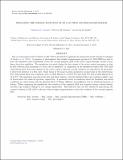Files in this item
Simulating the coronal evolution of AR 11437 using SDO/HMI magnetograms
Item metadata
| dc.contributor.author | Yardley, Stephanie L. | |
| dc.contributor.author | Mackay, Duncan H. | |
| dc.contributor.author | Green, Lucie M. | |
| dc.date.accessioned | 2017-12-01T17:30:10Z | |
| dc.date.available | 2017-12-01T17:30:10Z | |
| dc.date.issued | 2018-01-10 | |
| dc.identifier | 251679123 | |
| dc.identifier | 3657cee1-54c0-419f-a829-b2728f3fd75f | |
| dc.identifier | 85040694448 | |
| dc.identifier | 000419796100009 | |
| dc.identifier.citation | Yardley , S L , Mackay , D H & Green , L M 2018 , ' Simulating the coronal evolution of AR 11437 using SDO/HMI magnetograms ' , Astrophysical Journal , vol. 852 , no. 2 , 82 . https://doi.org/10.3847/1538-4357/aa9f20 | en |
| dc.identifier.issn | 0004-637X | |
| dc.identifier.other | ORCID: /0000-0001-6065-8531/work/58055448 | |
| dc.identifier.uri | https://hdl.handle.net/10023/12226 | |
| dc.description | Funding: STFC via the Consolidated Grant SMC1/YST025 (SLY), STFC and the Levehulme Trust (DHM). | en |
| dc.description.abstract | The coronal magnetic field evolution of AR 11437 is simulated by applying the magnetofrictional relaxation technique of Mackay et al. (2011). A sequence of photospheric line-of-sight magnetograms produced by SDO/HMI are used todrive the simulation and continuously evolve the coronal magnetic field of the active region through a series of nonlinear force-free equilibria. The simulation is started during the first stages of the active region emergence so that its full evolution from emergence to decay can be simulated. A comparison of the simulation results with SDO/AIA observations show that many aspects of the active region's observed coronal evolution are reproduced. In particular,it shows the presence of a flux rope, which forms at the same location as sheared coronal loops in the observations. The observations show that eruptions occur on 2012 March 17 at 05:09 UT and 10:45 UT and on 2012 March 20 at14:31 UT. The simulation reproduces the first and third eruption, with the simulated flux rope erupting roughly 1 and10 hours before the observed ejections, respectively. A parameter study is conducted where the boundary and initial conditions are varied along with the physical effects of Ohmic diffusion, hyperdiffusion and an additional injection of helicity. When comparing the simulations, the evolution of the magnetic field, free magnetic energy, relative helicity and flux rope eruption timings do not change significantly. This indicates that the key element in reproducing the coronal evolution of AR 11437 is the use of line-of-sight magnetograms to drive the evolution of the coronal magnetic field. | |
| dc.format.extent | 14 | |
| dc.format.extent | 13712711 | |
| dc.language.iso | eng | |
| dc.relation.ispartof | Astrophysical Journal | en |
| dc.subject | Sun: activity | en |
| dc.subject | Sun: corona | en |
| dc.subject | Sun: coronal mass ejections (CMEs) | en |
| dc.subject | Sun: evolution | en |
| dc.subject | Sun: magnetic fields | en |
| dc.subject | Sun: photosphere | en |
| dc.subject | QB Astronomy | en |
| dc.subject | QC Physics | en |
| dc.subject | 3rd-DAS | en |
| dc.subject.lcc | QB | en |
| dc.subject.lcc | QC | en |
| dc.title | Simulating the coronal evolution of AR 11437 using SDO/HMI magnetograms | en |
| dc.type | Journal article | en |
| dc.contributor.sponsor | Science & Technology Facilities Council | en |
| dc.contributor.sponsor | Science & Technology Facilities Council | en |
| dc.contributor.institution | University of St Andrews. Applied Mathematics | en |
| dc.identifier.doi | 10.3847/1538-4357/aa9f20 | |
| dc.description.status | Peer reviewed | en |
| dc.identifier.grantnumber | ST/N000609/1 | en |
| dc.identifier.grantnumber | PO: 4070103637 | en |
This item appears in the following Collection(s)
Items in the St Andrews Research Repository are protected by copyright, with all rights reserved, unless otherwise indicated.

